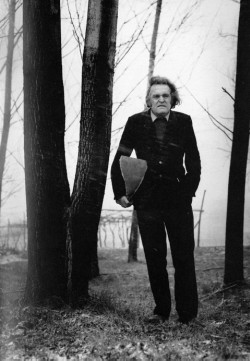 Mario Merz
Mario Merz
Mario Merz
意大利當代著名藝術家,“貧困藝術”運動的領航人, 代表作有《夢幻城市》、《閃電平原》等。
Abte pevera它可以理解為“窮的藝術”或“貧困藝術”。貧困藝術最初是由意大利著名評論家吉馬諾·塞朗提出,1968年,塞朗在波洛拿組織了一次題為《貧困藝術》的展覽,次年又相繼推出一本《貧困藝術》一書,當時在意大利起到了不少的影響。貧困藝術其含意不是針對作品本身的質量而言的,而是指藝術家所選擇的材料是普通的或日用的。他們比較注重物質簡樸寒酸的環境和對于物品制作過程、功能、甚至是它們辯證性質的深層次的理解。這些物質在保留其自身的原始特征的同時還產生出可識別的形象性以及情感性,他包含了某種復雜的概念和結構。是在材料和技術中提煉的詩意。
Mario Merz was born January 1, 1925, in Milan. He grew up in Turin and attended medical school for two years at the Università degli Studi di Torino. During World War II he joined the anti-Fascist group Giustizia e Libertà and was arrested in 1945 and confined to jail, where he drew incessantly on whatever material he could find. In 1950, he began to paint with oil on canvas. His first solo exhibition, held at Galleria La Bussola, Turin, in 1954, included paintings whose organic imagery Merz considered representative of ecological systems. By 1966, he began to pierce canvases and objects, such as bottles, umbrellas, and raincoats, with neon tubes, altering the materials by symbolically infusing them with energy.
馬里奧·梅茨1925年1月生于意大利米蘭,長于都靈,曾入都靈degli studi di 大學醫學院學習兩年。二次大戰中因參加反法西斯運動被捕入獄,在獄中他想盡一切辦法用可得到的一切材料畫畫。1950年他開始在帆布上創作油畫,1954年在都靈Bussola畫廊舉辦首次個人作品展,包括梅茨考慮過從典型的生態系統角度組織肖像油畫。1966年,他開始用霓虹燈刺穿帆布和物體,如:瓶子、雨傘和雨衣,以此改變物質的象征性注入新的能量。
In 1967, he embarked on an association with several artists, including Giovanni Anselmo, Alighiero Boetti, Luciano Fabro, Jannis Kounellis, Giulio Paolini, Giuseppe Penone, Michelangelo Pistoletto, and Gilberto Zorio, which became a loosely defined art movement labeled Arte Povera by critic and curator Germano Celant. This movement was marked by an anti-elitist aesthetic, incorporating humble materials drawn from everyday life and the organic world in protest of the dehumanizing nature of industrialization and consumer capitalism.
1967年,他走入了一個由幾個藝術家組成的協會,包括Giovanni Anselmo, Alighiero Boetti, Luciano Fabro, Jannis Kounellis, Giulio Paolini, Giuseppe Penone, Michelangelo Pistoletto,和 Gilberto Zorio,被批評家和策劃人杰爾瑪諾(Germano Celant)定義為“貧困藝術”(Arte Povera)運動的標志,這次運動明顯的反審美精英,主張從每日生活中提煉粗微的材料組織世界,反對失掉人性自然的資本主義消費和工業化。
In 1968, Merz adopted one of his signature motifs, the igloo. It was constructed with a metal skeleton and covered with fragments of clay, wax, mud, glass, burlap, and bundles of branches, and often political or literary phrases in neon tubing. He participated in significant international exhibitions of Conceptual, Process, and Minimalist Art, such as Arte povera + azioni povera at the Arsenali dell’Antica Repubblica, Amalfi, and Live in Your Head: When Attitudes Become Form at the Kunsthalle Bern in 1968; the latter exhibition traveled to Krefeld, Germany, and to London. In 1970, Merz began to utilize the Fibonacci formula of mathematical progression within his works, transmitting the concept visually through the use of the numerals and the figure of a spiral. By the time of his first solo museum exhibition in the United States, at the Walker Art Center, Minneapolis, in 1972, he had also added stacked newspapers, archetypal animals, and motorcycles to his iconography, to be joined later by the table, symbolic as a locus of the human need for fulfillment and interaction. Merz often responds to the specific environment of his exhibitions by incorporating materials indigenous to the area as well as adjusting the scale of the work to the site. His first solo European museum exhibition took place at the Kunsthalle Basel in 1975, and his most recent retrospective was organized by the Solomon R Guggenheim Museum, New York, in 1989. Merz works in Turin, where he resides with his wife, artist Marisa Merz.
1968年,馬里奧·梅茨采用在圓頂建筑主題簽名的方法,它用金屬骨架和隱蔽的粘土碎片,蠟、泥、玻璃、粗麻布、和捆綁的枝條構成,常常政治或文學上表達用霓虹燈。他參與重大的國際概念上的展覽,極簡主義藝術,如貧困藝術加 azioni povera......
|

